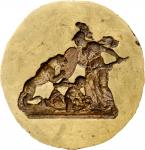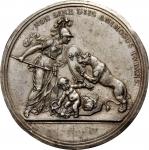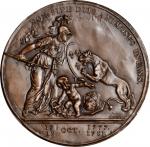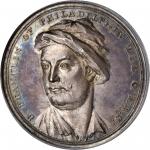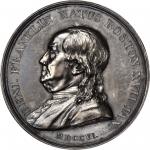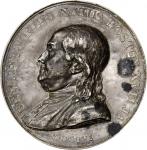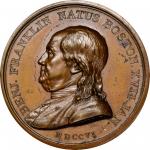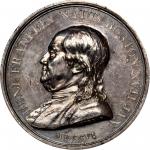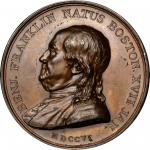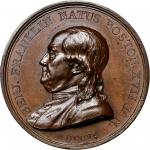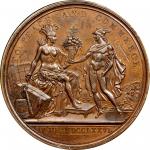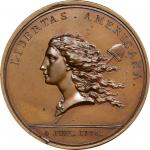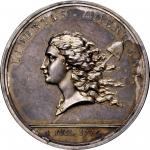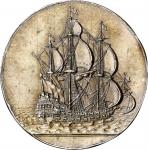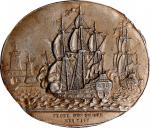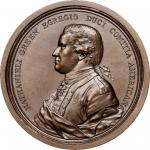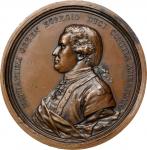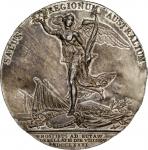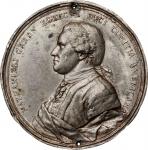1781 Libertas Americana medal. Betts-615. Copper. Original. Paris Mint. 47.8 mm, 710.6 grains. 3.5 - 3.6 mm thick. Choice Mint State.Plain concave edge, with collaring marks or witness lines at 11:30 and 2:30, relative to the obverse. Ideally reflective medium brown with pale blue highlights and traces of faded mint color around the peripheries. A third and final beautiful example of this most-desired American medal. Some scattered verdigris or surface dirt adheres inside the obverse rim, harming nothing. Only minor marks are seen; the only two of consequence are below the stop at 12:00, close to the base of S in LIBERTAS, and below ER of that word adjacent to the hairline. Well detailed and lovely on both sides, a very pleasing example.<p>The collaring marks visible here are identical to the silver specimen above, and the mark near 11:30 again looks like a crack in the collar die. The die state is a trifle later than the silver piece and a bit earlier than the copper specimen in the preceding lot. <p>A Libertas Americana medal has always been a desirable item. The earliest documented American auction appearance for one seems to be lot 567 of the April 1846 sale of the D.B. Warden Collection, sold in New York by Horatio Hill. Though principally a book sale, Wardens estate included a Libertas Americana medal and a John Paul Jones medal. The first auction appearance in England was earlier still - May 1817 - when the collection of Thomas Brand Hollis was offered by Mr. Sotheby. Franklin knew Hollis and his late husband were coin collectors and sent Thomas Brand a specimen of the medal specifically for his cabinet. It was sold together with a medal of Washington, another of Linneus, and a Charleston Social Club medal of 1763 (!) as lot 270. The Libertas Americana medal was not yet 35 years old. Within a few years of the landmark 1851 Roper sale, where Lot A, Number 12 was described as "Medal - Libertas Americana, struck in Paris," numismatic specialty auctions began to become commonplace. Appearances of the Libertas Americana medal, the nations favorite medal then as now, followed suit.<p><strong>The Libertas Americana Medal</strong><p>There is almost nothing we can say about the Libertas Americana medal that has not been said before. It is the most recognizable early American medal, the unanimous choice as #1 in the <em>100 Greatest Medals and Tokens book,</em> and the inspiration for many of the United States coinage designs of the 18th century. It is legendary beyond its rarity, historic beyond its celebrated creation narrative, and important far beyond the world of numismatics.<p>While not properly a part of the Comitia Americana series - it was a medal authorized by Benjamin Franklin as an individual, not the Continental Congress - the Libertas Americana medal has been adopted into this group ever since Thomas Jefferson saw fit to place one in George Washingtons set of Comitia Americana medals in the summer of 1789. By that time, the medal was several years old, as it had been completed and distributed by Franklin in the spring of 1783. Franklin sent his medal far and wide, in France, in the United States, and beyond. His postal accounts show that in April 1783 he twice hired a carriage to special deliver his medal to its recipient. Jefferson had one on display at Monticello, inventoried as "a medal by Dr. Franklin." The Dutch artist Johann-Georg Holtzhey had a friend write to John Adams to ask how he and his friends could obtain one. As the medals found their homes in April and May 1783, Franklins mailbox filled up with thank you notes from across the continent. On April 15 of that year, Franklin sent a bundle of them to Philadelphia to hand out to the members of Congress, including a silver one for Congress president, future Mint Director Elias Boudinot. <p>In September 1783, Franklin wrote to Boudinot "I am happy that both the Device and Workmanship of the Medal are approvd with you, as they have the good Fortune to be by the best Judges on this side the Water. It has been esteemd a well-timed as well as a well-merited Compliment here, and has had good Effects. Since the two first which you mention as received, I have sent by different Opportunities so many as that every Member of Congress might have One. I hope they are come safe to hand by this time." Boudinot confirmed their arrival and described how he parceled them out: "I have received the additional number of Medals, which, not having any particular directions from you, I distributed among the Members of Congress, presented one to the Governor of each State, and the Ministers round Congress."<p>Every Libertas Americana medal was once handled by Franklin, every great American and Frenchman of the era knew about the medal and associated it with Franklin, and every Libertas Americana medal surviving today has a remarkably historic provenance, whether it is fully documented or not.<p>The quoted descriptions of the medal come from the explication published in France in May 1783, quite possibly written by Franklin himself. This explication was printed as a leaflet and intended to accompany the medal itself.<p><strong>Obverse:</strong> "The Head representing American Liberty has its tresses floating in the air, to shew that she is in activity. The Cap carried on a Spear is her Ensign. The Date underneath is that of the Declaration of Independence."<p><strong>Reverse: </strong>"The United States of America are represented by an Infant Hercules, cradled in a Buckler to shew that they are nursed in War. A Leopard, representing England, comes with two serpents to destroy the Infant. France represented by a Minerva, comes armed to his succour, and under her protection he strangles the two serpents, while she guards him from the Leopard, by her shield marked with Fleurs-de-Lis. The Legend is a line of Horace, importing that the Infant was not without divine assistance. The Dates below are those of the two Capitulations of Saratoga & York-Town, whereby two entire English Armies that had enterd and ravaged the United States with fire & sword, were extinguished." In Franklins symbolism, this depiction recalls Hera, the stepmother of Hercules, releasing two snakes to kill Hercules in his cradle; those two snakes were the armies of Burgoyne (defeated at Saratoga) and Cornwallis (defeated at Yorktown).<p>From the John W. Adams Collection. Acquired from Ted Craige.

